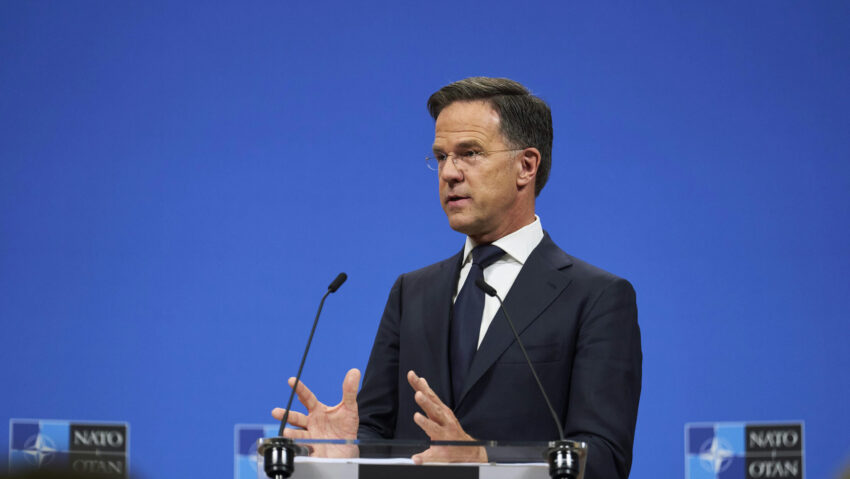NATO Secretary General Mark Rutte speaks to media before meetings of NATO defense ministers in Brussels (NATO)
BELFAST — The US has no immediate plans to drawdown its armed forces in Europe, NATO’s top official said today, despite Washington prioritizing talks on the matter with the alliance.
“There are no plans at the moment for the US to withdraw troops,” said Mark Rutte, NATO Secretary General, ahead of an alliance defense ministers meeting in Brussels. “What we do know is that the US is completely committed to NATO.”
Rutte specifically dismissed the idea that his position contradicts that of Matthew Whitaker, US ambassador to NATO. “We speak every week, and I know exactly what he said, and what he said is exactly as I said, ‘We have to pivot more towards other theaters … and we will make sure that there will be no capability gaps in Europe.’”
In May, Whitaker reportedly said that proposals to withdraw tens of thousands of troops from Europe would be discussed “later” this year, but no sooner than the forthcoming NATO Summit.
Jan Senior, fellow of transatlantic defense and security at the Center for European Policy Analysis, said last month that cuts to US forces in Europe is not “feasible” ahead of the Summit, because of the length of time it takes to work up a global posture review.
Max Bergmann, director of the Europe, Russia, and Eurasia Program at the Center for Strategic and International Studies, previously claimed that an “internal fight” in the Pentagon had erupted over “how deep the cuts” to US forces in Europe will be. The White House and Pentagon did not immediately respond to a request for comment for this report.
In the wake of the Ukraine war, the US decided to deploy or extend an additional 20,000 troops to Europe, lifting its total presence to over 100,000. The move included a “first permanent” stationing of troops on NATO’s eastern flank, according to a DoD fact sheet.
Although the future talks and the timing of a US withdrawal have not been set, they continue to cast a dark shadow over both the defense ministers meeting and the Summit, set to take place in The Hague next month.
For the moment, Rutte said that allies will formally sign off on new capability targets and “discuss” a two-tiered increased defense spending pledge at the ministerial in Brussels.
RELATED: NATO summit could see 5% spending pledge, but analysts say it’s not that simple
Though he did not offer any specific figures or a timeline, it has been widely reported that Rutte’s increased defense spending proposal for NATO allies, revolves around an uplift from the existing 2 percent GDP target to 3.5 percent on “core” defense capabilities and an additional 1.5 percent on other security-related investments like infrastructure or cybersecurity.
The new spending push has been developed in response to pressure from President Donald Trump that Europe does more for its own security. An agreement on the hike could be reached at the summit, dependent on approval from all 32 allies. A “new defense investment plan” will be “at the heart of” the gathering, said Rutte.
For the moment, the alliance will take a “huge leap forward” once the new capability targets are signed off. They cover, outlined Rutte, the “forces and concrete capabilities the allies need to provide, to strengthen our deterrence and defense,” with “top priorities,” including air and missile defense, long range weapons, logistics, and “large land maneuver formations.”
He said the alliance will evaluate capability gaps in “our collective defense to protect ourselves against any Russian aggression,” and warned that Russian President Vladimir Putin “should know” that if he was to attack NATO territory “our reaction will be devastating.”
In the meantime, Rutte said he also expects additional military aid “commitments” for Ukraine to be approved at a Ukraine Defense Contact Group meeting, also scheduled to take place later today. The US will participate in the Contact Group, said Rutte, which will be jointly chaired by Germany and the UK, but US Defense Secretary Pete Hegseth is not expected to attend.
Rutte is also supportive of the US “taking the lead” on Ukraine and Russia peace talks, and he welcomed Trump’s decision to initially break the “deadlock” between the two countries at war.
It was “never promised to Ukraine that potential NATO membership will be part of a peace deal or a cease fire,” said Rutte, though he reiterated the long-standing position of the alliance that Kyiv remains on an “irreversible path” to membership. There remains no timeline for a membership invitation.
Click this link for the original source of this article.
Author: Tim Martin
This content is courtesy of, and owned and copyrighted by, https://breakingdefense.com and its author. This content is made available by use of the public RSS feed offered by the host site and is used for educational purposes only. If you are the author or represent the host site and would like this content removed now and in the future, please contact USSANews.com using the email address in the Contact page found in the website menu.








